Paschke Online
Designs Ink Publishing Article Archive and Reference Library
Articles by Chris A. Paschke, CPF GCF
"Canvases…Then and Now - Part II"
April 2004
Welcome back. Last month I began this two part article on mounting assorted types of canvases: traditional oils, canvas transfers, limited edition gicleés, and open edition wide format digitals. The simple days of just needing to know the correct way to preserve and stretch an oil painting has given way to the need of identifying and reassessing the damage potential that traditional stretching methods might incur on canvases created using 21st century technologies. What a headache.
I would like to take this opportunity to publicly thank Wild Apple Graphics for their continued support in framing education and the advancement of our digital knowledge by supplying me with the canvas samples for this article. When I requested these samples for testing little did they realize what torture I would put their images through and that I would fold, spindle and mutilate them in the name of technology, all for the benefit of continuing education in our industry. Now, for the rest of the story.
Gicleés and Limited Edition Canvases
Gicleé merely means spit ink (inkjet), but has come to refer to an upper end, digitized image, often a limited edition, rather then an open edition inkjet image. And a limited edition (LE) is still a limited edition and must always be respected as such. We are still in a gray area that is unsure of how to handle these reproductions. On one hand we have been taught never to alter any kind of LE, on the other we are being told traditional offset limited editions and digital limited editions are two separate mediums with two separate sets of rules, which is true. But until the rules have been set we must follow current state-of-the-art standards, which currently support being noninvasive to these collectibles.
With the introduction of high quality images printed with dye and computers rather than ink and printing presses, the look and feel of canvas reproductions has exploded. The original problems of light sensitivity and water solubility have been addressed by manufacturers and many of today's fine art digitals now use pigmented inks and coatings making them far more lightfast and water resistant. Notice I said water resistant and not waterproof. This is important for two reasons: first, they should still be placed under glass for ultimate protection; and second, no framer should spray or apply any coating over any image to further protect it. The wrong technique or solution can do irreparable damage, and coatings should be left to the artist or printer alone.
Open Edition Digital Canvases
So where do open edition digital reproductions fit in to the world of gicleés? With the onset of digital printing the reproduction of original oil and acrylic paintings has taken off. Wide format printers allow even the smallest 2x3” high quality image to be enlarged and reproduced into a 24x36” masterpiece, printed directly to prepared canvas.
Open edition images regardless of paper print or canvas are considered decorative art and have a distinctly separate set of rules from the above LE gicleé canvases. Being open edition, affordable, replaceable images they may be altered as needed and mounted when the mounting method matches that of the printing technique. This technically allows them to be either dry/heat mounted or cold mounted, if they can tolerate the abuse without damage.
There are two types of substrate or media used in inkjet printing: uncoated and coated stock, somewhat similar to raw and primed canvas. Plain uncoated papers, like 26# bright white for a desktop printer, tend to absorb ink making images fuzzier. Coated media (papers and canvas) prevent bleeding which result in a crisper image. There are also two types of coatings: swellable and porous. In this case, swellable does not mean prone to bleeding.
Swellable coatings expand in the presence of moisture in water-based inks allowing the color to penetrate the top coating. Swellable coatings are often found in digital photo reproduction because top glossy special layers have been added to maximize brightness and replicate the look of a traditional photo. The problem is these are very slow to dry and a one to two week dry down period is highly recommended prior to framing.
Porous coatings have tiny cavities into which the ink is deposited preventing bleeding and creating an even higher resistance to humidity and moisture. This material dries quickly and may be handled without excessive fear of smudging and is desired for use with pigmented inks.
In order for canvas to be receptive to pigmented or dye based inks the porous fiber must be coated with an ink receptive surface as mentioned above. Most wide format open edition digital canvases are printed with pigmented inks on canvas treated with a receptive porous coating. Often these images are also coated with a light surface glaze to help make them more water resistant after printing. The samples of canvas used in this article feel like a heavy coated canvas and tear down the grain like any fabric, but also show flaking ink when aggressively crinkled and fitted at the corners (photo 1).
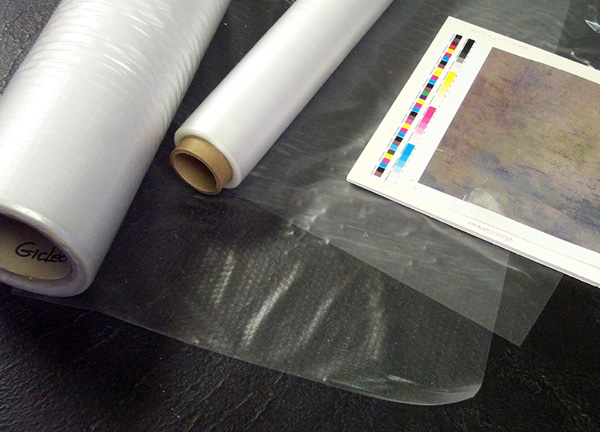 Photo 1: Giclee Adhesives
Photo 1: Giclee Adhesives
Drytac GicleeMount is left with Bienfang ClearMount center, both adhesives designed for use with pigmented digitals on fine art papers without long term yellowing or damage. Notice the perforations in the Drytac sheet. Right is a section of canvas from Wild Apple Graphics that has been dry mounted at 200 degrees for three minutes with no damage.
Dry Mounting Canvases
The beauty of gicleé images is their ability to duplicate an original and the fact they may be on a canvas material. A line of dry mount adhesives have been released that are designed to work with pigment inkjet images without damage. I reported on the first of these designed for use with Hahnemuhle fine art paper in PFM June 2003, “New Technologies”. Though limited editions should not be permanently mounted, open edition images may be as long as the mounting method does no harm.
ClearMount and GicleeMount are two relatively new permanent dry mount film adhesives specifically developed for use with open edition inkjet images (photo 2). They mount at temperatures of 190-225°F claiming to be safe for use with digital pigmented inks in dry mount framing equipment. By the way, like the archivally named tissue adhesives of twenty years ago the above named GicleeMount is not meant to be used with high end limited edition gicleés or computer generated original fine art. The name is a little misleading. Both adhesives were designed to be safe for use with pigmented piezo and wide format inkjet technology, not dyes from a thermal bubblejet printer. Please remember gicleé is an inkjet but is often a limited edition. Though these adhesives are neutral pH and safe for use with pigmented inks, they should only used with open edition decorative inkjet imagery, not limited edition gicleés.
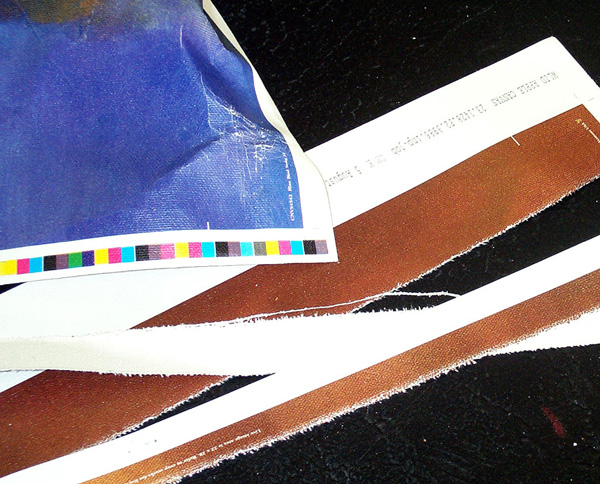 Photo 2: Tearing and Cracked Ink
Photo 2: Tearing and Cracked Ink
The printed image is on what appears to be a canvas fabric, which also tears like a cloth along the grain, but when aggressively wrinkled the inks will crack as the blue corner in this photo.
I recently heat tested the heat tolerances of a few sample canvas releases from Wild Apple Graphics in my mechanical press at 200°F for three minutes onto foam board using a porous permanent tissue adhesive with no problems. With apologies to Wild Apple, they claimed the images to be offset lithographic canvas prints, but the CMYK and color scale in the borders makes them appear to be a digital wide format print to me. I have recently been reading of the difficulty in printing onto real canvas using traditional offset lithographic methods because of image registration shifting, but perhaps Wild Apple has a publishing firm that has resolved this issue. Check with individual publishers or manufacturers for printing information prior to hot or cold mounting any image.
Back to Canvas Stretching
Last month I mentioned the problem of sagging canvases when attempting to stretch vinyl coated canvas transfers and wide format coated digitals. Another problem with coated canvas for digital printing is the possibility of the ink cracking and flaking from the corners during stretching (photo 3). A swellable media where the ink sits on the canvas surface may flake while a porous one may not, you never know so plan for it. It is the type of printing substrate/media and its preparation that determines an ink and canvases mounting tolerances, not the amount of aggressive handling.
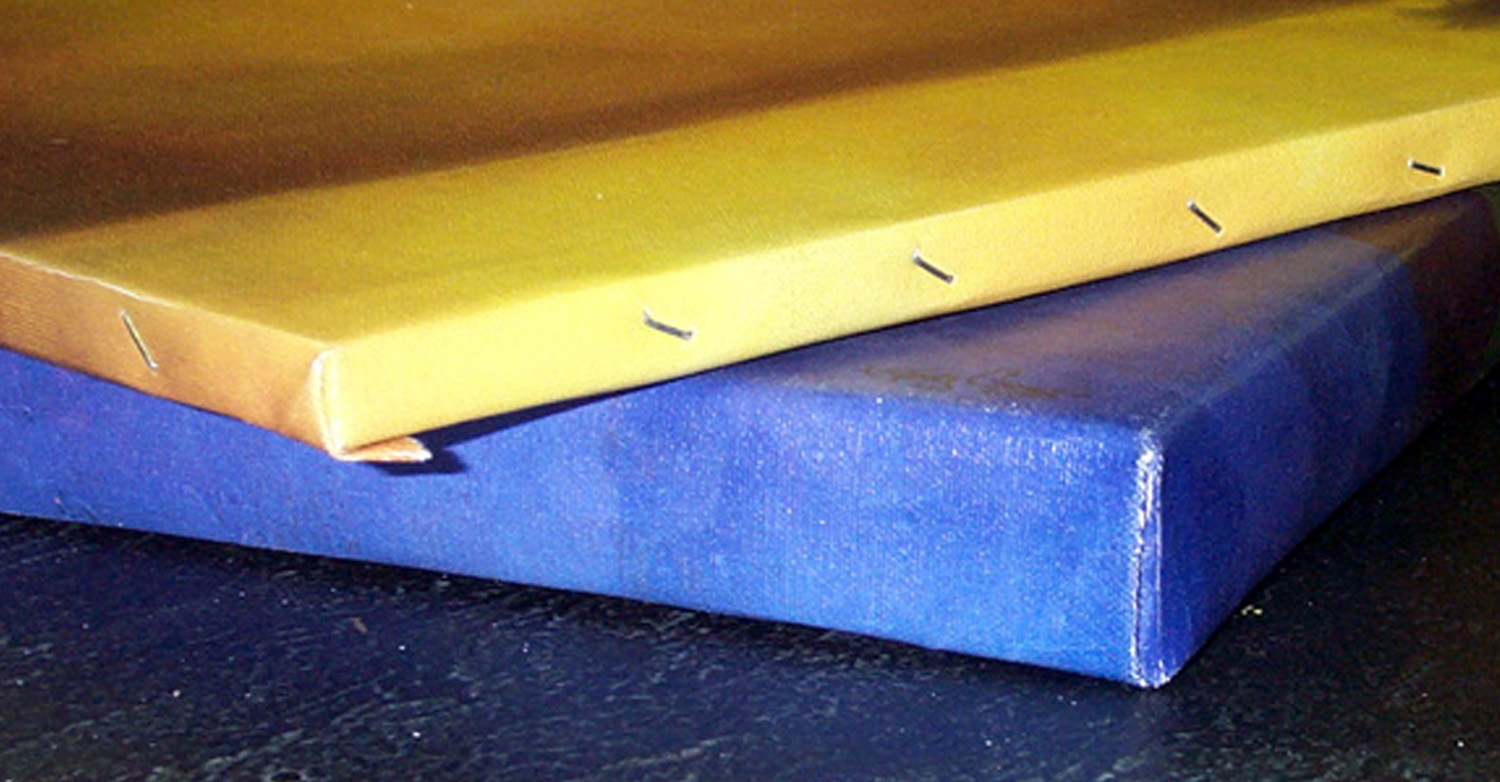 Photo 3: Stretched Canvases
Photo 3: Stretched Canvases
The top canvas has been traditionally stretched onto ½” bars with diagonal staples in the edges. The 2” deep wrapped strainer on the bottom illustrates the stresses of stretching porous coated canvases regardless of bar depth.
If a canvas has been traditionally stretched to conventional ½” bars there should be diagonal staples in the edges (sides) rather than horizontal. When there is adequate printed canvas to allow for it, a deep wrapped strainer offers a different option and look. The stretched canvas on the bottom in the photo illustrates the same stresses of cracking inks when stretching porous coated canvases regardless of bar depth.
Wrapped Canvases
A relatively new trend and retro come-back with canvas images is the wrapping of the image around the edges of the wood frame to the back making the image appear to have also been painted on the sides. This is reminiscent of the large minimalist paintings of Pollack, Rothko and Kline form the modern era of contemporary abstract expressionist painting. There is a significant difference between the stretching of images as canvas wraps and that of standard stretcher bars. Regular bars are shallow, generally under an inch, while wrapped canvases are much wider and boxy measuring 1½” to 2” deep (photo 4).
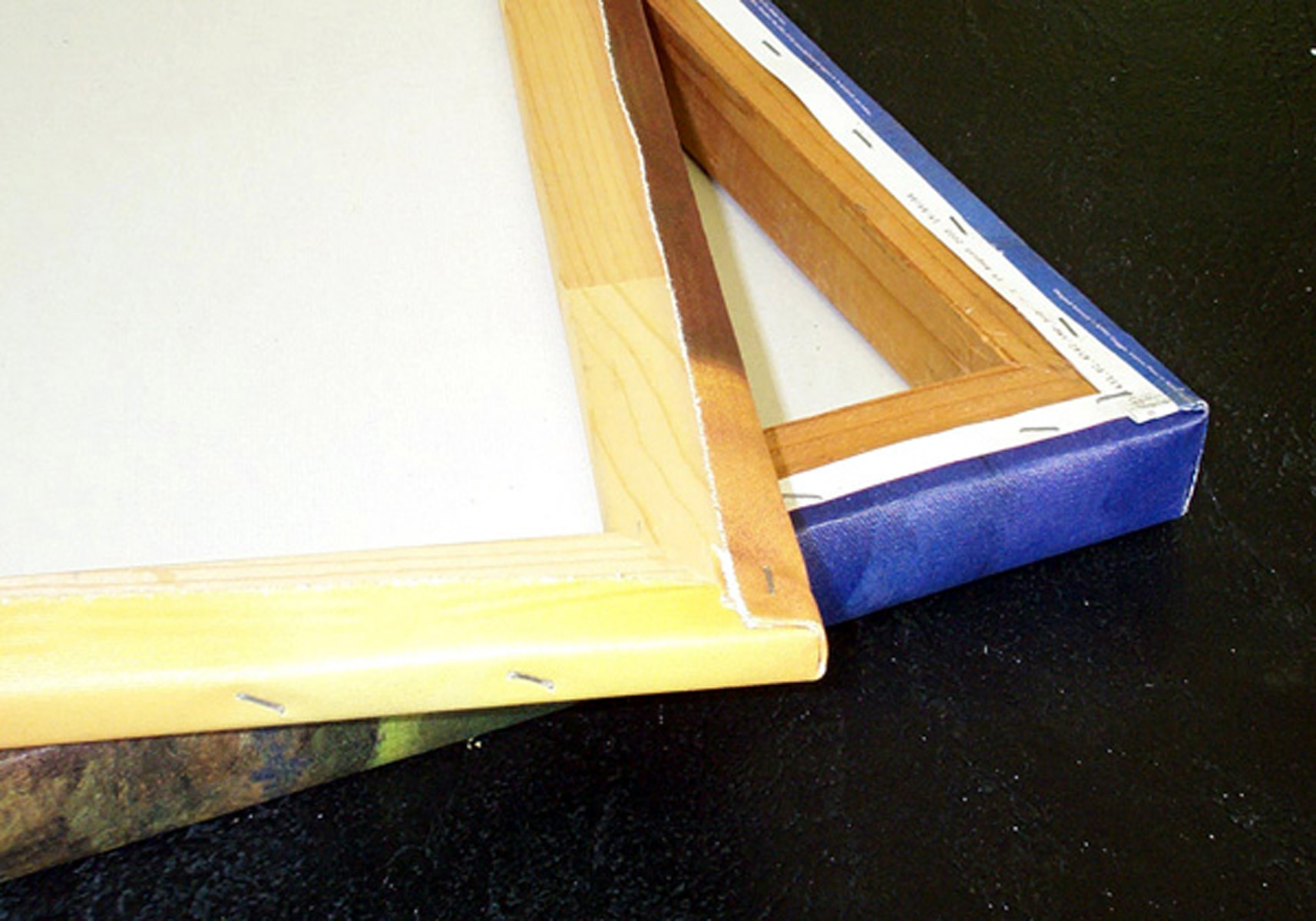 Photo 4: Depth of Bars
Photo 4: Depth of Bars
There is a significant difference between the stretching of images as canvas wraps and that of standard stretcher bars. Regular bars are shallow, generally under an inch, while wrapped canvases are much wider and boxy measuring 1½” to 2” deep. These are both strainers without corner keys, built only as article samples for depth and stress.
The canvas images in this article were deliberately printed oversized with crop marks to accommodate up to 1½” side wrapping over a narrow bar or wider wooden frame. This allows for free hanging without a frame - perish the thought - or placing into a canvas float frame (photo 5). Wrapped wooden frames are best if built out of 1x3” or 2x2” hardwood for this look. Though currently a popular trend in Europe, it has not reached its momentum in the United States quite yet. This type of stretching does not allow for ease of expansion when needed by the art as mentioned above, with the potential for sagging and edge marks is a possible result. Digital stretched and wrapped canvases can be difficult to handle at best.
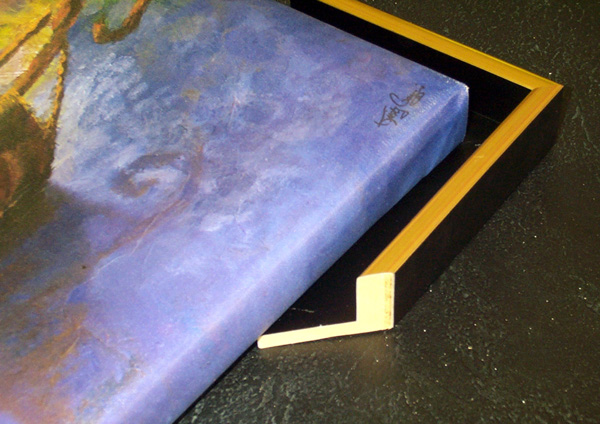 Photo 5: Canvas Wrapping
Photo 5: Canvas Wrapping
Stretching canvases onto 2x2” deep box frames is reminiscent of the large minimalist paintings of Pollack, Rothko and Kline of the Abstract Expressionist School. Canvases can be free hung or placed into a canvas float moulding.
Plastic Canvas
The times, they are a-changin': original oils, canvas transfers, limited edition gicleés, and wide format canvas digitals, all are forms of today's canvas images. Starving artist sales featuring original oils are the real thing though mass produced in assembly line format at very low end retail pricing. The positive aspect of these is they do handle like the real thing because they are often already on bars. They are not the problem - the reproductions on vinyl and plastic canvases are. They may be touchy, heat sensitive, and coated with additional surface coatings to help protect them. Good luck with these babies.
The public seems to be reveling in their desire for canvas textures, so the understanding of how to correctly handle the pieces they bring in or purchase for framing is imperative. Many inexpensive reproductions are plastic coated renditions of the real thing and though tough to handle at least they are getting into consumer homes. Dry mounting may devalue some images while stretching may end up with saggy canvas. What are we to do? There is no one answer I'm afraid, welcome to the 21st century.
And there's also the “should it be behind glass?” discussion. We'll have to save that for another issue. In the mean time use your common sense and do your best to identify what it is you have been asked to frame. Knowing what it is…is half the battle.
END
Copyright © 2004 Chris A Paschke
For more articles on mounting basics look under the mounting section in Articles by Subject.
Additional information on all types of mounting is found in:
The Mounting and Laminating Handbook, Second Edition, 2002,
The Mounting And Laminating Handbook, Third Edition, 2008 and
Creative Mounting, Wrapping, And Laminating, 2000 will teach you everything you need to know about getting the most from your dry mount equipment and materials as an innovative frame designer.
All books are available from Designs Ink Publishing through this website.
Chris A Paschke, CPF GCF
Designs Ink
Designs Ink Publishing
785 Tucker Road, Suite G-183
Tehachapi, CA 93561
P 661-821-2188
chris@designsinkart.com
 Photo 1: Giclee Adhesives
Photo 1: Giclee Adhesives Photo 2: Tearing and Cracked Ink
Photo 2: Tearing and Cracked Ink Photo 3: Stretched Canvases
Photo 3: Stretched Canvases Photo 4: Depth of Bars
Photo 4: Depth of Bars Photo 5: Canvas Wrapping
Photo 5: Canvas Wrapping